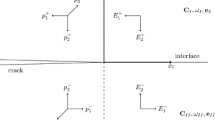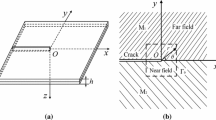Abstract
This paper presents an analysis of symmetric and skew-symmetric weight functions for in-plane interfacial crack problems in piezoelectric bimaterials. The symmetric weight function matrix is obtained by means of the solution of a Wiener–Hopf functional equation and the skew-symmetric weight function matrix is developed by the construction of a corresponding full field solution. The explicit expressions for the symmetric and skew-symmetric weight functions are given and applied to in-plane deformation problems for a semi-infinite crack between two dissimilar piezoelectric materials. The validity of the present method in the determination of the field intensity factors is demonstrated by illustrative examples, in which both piezoelectric bimaterials and piezoelectric/elastic bimaterials are considered. It is shown that, for the present interfacial crack problem, both symmetric and skew-symmetric weight function matrices are necessary in the general integral formula for the evaluation of field intensity factors, and that the contribution of the skew-symmetric element of the applied load is not negligible in fracture analysis.






Similar content being viewed by others
References
Antipov YA (1999) An exact solution of the 3-D problem of an interface semi-infinite plane crack. J Mech Phys Solids 47:1051–1093
Arfken GB, Weber HJ (2005) Mathematical methods for physicists. Elsevier Academic Press, San Diego
Beom HG, Atluri SN (1996) Near-tip fields and intensity factors for interfacial cracks in dissimilar anisotropic piezoelectric media. Int J Fract 75:163–183
Bueckner HF (1970) A novel principle for the computation of stress intensity factors. Zeitschrift fur Angewandte Mathematik und Mechanik 50:529–546
Bueckner HF (1973) Field singularities and related integral representations. Mech Fract 1:239–314
Chen YZ (1989) Weight function technique in a more general case. Eng Fract Mech 33:983–986
Chen YZ, Hasebe N (1994) Eigenfunction expansion and higher order weight functions of interface cracks. J Appl Mech 61:843–849
Gao CF, Wang MZ (2001) Collinear permeable cracks in thermopiezoelectric materials. Mech Mater 33:1–9
Gao H (1991) Weight function analysis of interface crack: mismatch versus oscillation. J Appl Mech 58:931–938
Gao H (1992) Weight function method for interface cracks in anisotropic biomaterials. Int J Fract 56:138–158
Gu B, Yu SW, Feng XQ (2002) Transient response of an interface crack between dissimilar piezoelectric layers under mechanical impacts. Int J Solids Struct 39:1743–1756
Herrmann KP, Loboda VV, Govorukha VB (2001) On contact zone models for an electrically impermeable interface crack in a piezoelectric bimaterial. Int J Fract 111:203–227
Hu K, Fu J, Yang Z (2014) Moving Dugdale type crack along the interface of two dissimilar piezoelectric materials. Theor Appl Fract Mech 74:157–163
Labbens RC, Heliot J, Pellisier-Tanon A (1976) Weight functions for three-dimensional crack problems. Cracks Fract. In: ASTM STP, 601. ASTM, Philadelphia, pp 448–467
Labbens RC, Pellisier-Tanon A, Heliot J (1975) Practical method for calculation stress intensity factors through weight functions. Mech Crack Growth. In: ASTM STP, 590. ASTM, Philadelphia, pp 368–385
Lazarus V, Leblond J (1998) Three-dimensional crack-face weight functions for the semi-infinite interface crack-I: variation of the stress intensity factors due to some small perturbation of the crack front. J Mech Phys Solids 46:489–511
Ma LF, Chen YH (2001) Weight functions for interface cracks in dissimilar anisotropic piezoelectric materials. Int J Fract 110:263–279
Ma LF, Chen YH (2004) Weight functions for interface cracks in dissimilar anisotropic materials. Acta Mech Sin 20:82–88
McMeeking R, Ricoeur A (2003) The weight function for cracks in piezoelectrics. Int J Solids Struct 40:6143–6162
Morini L, Piccolroaz A, Mishuris G, Radi E (2013) Integral identities for a semi-infinite interfacial crack in anisotropic elastic bimaterials. Int J Solids Struct 50:1437–1448
Morini L, Radi E, Movchan AB, Movchan NV (2012) Stroh formalism in analysis of skew-symmetric and symmetric weight functions for interfacial cracks. Math Mech Solids 18:135–152
Narita F, Yoshida M, Shindo Y (2004) Electroelastic effect induced by electrode embedded at the interface of two piezoelectric half-planes. Mech Mater 36:999–1006
Ou ZC, Wu XJ (2003) On the crack-tip stress singularity of interfacial cracks in transversely isotropic piezoelectric bimaterials. Int J Solids Struct 40:7499–7511
Ou ZC, Chen YH (2004) Interface crack problem in elastic/piezoelectric bimaterials. Int J Fract 130:427–454
Paris PC, McMeeking RM (1975) Efficient finite element methods for stress intensity factors using weight function. Int J Fract 11:R354–356
Paris PC, McMeeking RM, Tada H (1976) The weight function method for determining stress intensity factors. Cracks Fract. In: ASTM STP, 601. ASTM, Philadelphia, pp 471–489
Parks DM, Kamenetzky EM (1979) Weight functions from virtual crack extension. Int J Numer Methods Eng 14:1693–1706
Piccolroaz A, Mishuris G, Movchan AB (2007) Evaluation of the Lazarus–Leblond constants in the asymptotic model of the interfacial wavy crack. J Mech Phys Solids 55:1575–1600
Piccolroaz A, Mishuris G, Movchan AB (2009) Symmetric and skew-symmetric weight functions in 2D perturbation models for semi-infinite interfacial cracks. J Mech Phys Solids 57:1657–1682
Piccolroaz A, Mishuris G (2013) Integral identities for a semi-infinite interfacial crack in 2D and 3D elasticity. J Elast 110:117–140
Rice JR (1972) Some remarks on elastic crack-tip stress fields. Int J Solids Struct 8:751–758
Sham TL (1989) The theory of higher order weight functions for linear elastic plane problems. Int J Solids Struct 25:357–380
Sham TL, Zhou Y (1989) Weight function in two-dimensional bodies with arbitrary anisotropy. Int J Fract 40:13–41
Suo Z (1990) Singularities, interfaces and cracks in dissimilar anisotropic media. Proc R Soc A Math Phys 427:331–358
Suo Z, Kuo CM, Barnett DM (1992) Fracture mechanics for piezoelectric ceramics. J Mech Phys Solids 40:739–765
Vanderglas ML (1978) A stiffness derivative finite element technique for determination of influence functions. Int J Fract 14:R291–294
Wang BBL, Sun YG, Han JC, Du SY (2009) An interface electrode between two piezoelectric layers. Mech Mater 41:1–11
Willis J, Movchan A (1995) Dynamic weight functions for a moving crack. I. Mode I loading. J Mech Phys Solids 43:319–341
Acknowledgments
Support from the National Natural Science Foundation of China (Grant Nos. 11572358, 10772123 and 11072160) and the Training Program for Leading Talent in University Innovative Research Team in Hebei Province (LJRC006) is gratefully acknowledged.
Author information
Authors and Affiliations
Corresponding authors
Appendix A
Appendix A
Although for most \(\varepsilon \)-class piezoelectric bimaterials and piezoelectric/elastic bimaterials the eigenvectors \(\mathbf{w}\) take the form set out in Eq. (49), a minority of \(\varepsilon \)-class bimaterials lead to eigenvectors w with the following structures (Ou and Wu 2003; Ou and Chen 2004)
where \(l_1, m_i \) and \(n_i \left( {i=1,3} \right) \) are real. Since \(\mathbf{w}_3 \) completely coincide with Eq. (49), all the variables related to \(\mathbf{w}_3\) should have the same form as those in the previous section; for brevity, they will not be provided herein. Also, in this appendix, if no special explanation is given, all variables have the same form as those in the previous text.
Correspondingly, introducing \(\mathbf{U}^{i}=\left\{ {{\begin{array}{lll} {U_1^i }&{} {U_2^i }&{} {U_3^i } \\ \end{array} }} \right\} ^{\mathrm{T}}\) and tractions \(\varvec{\Sigma }^{i}=\left\{ {{\begin{array}{lll} {\Sigma _1^i }&{} {\Sigma _2^i }&{} {\Sigma _3^i } \\ \end{array} }} \right\} ^{\mathrm{T}} \quad \left( {i=1,2,3} \right) \) and taking \(C_I =1, C_{II} =C_D =0\) and \(C_{II} =1, C_I =C_D =0\) and \(C_D =1, C_I =C_{II} =0\), respectively, one gets
and their Fourier transforms are
where \(\omega \) and \(\rho \) have the same form as Eq. (52). The Fourier transforms of the three independent symmetric and skew-symmetric weight functions are consistent with Eqs. (53) and (54).
The symmetric weight function \([\mathbf{U}]({x_1 })\) is equal to zero for \(x_1 <0\), and for \(x_1 >0\) it takes the form
where
The skew-symmetric weight function \(\left\langle \mathbf{U} \right\rangle ({x_1 })\) is equal to \(\mathbf{D}_1 [\mathbf{U}]^{(+)}({x_1 })\) for \(x_1 >0\), and for \(x_1 <0\) it takes the form
where
The matrix \(\hat{{\Upsilon }}_1 \left( {\xi _+ } \right) \) in Eq. (70a) becomes
and correspondingly, \(\varvec{\Theta }_1 \) in Eq. (73a) is replaced by
where
and
Rights and permissions
About this article
Cite this article
Ma, P., Su, R.K.L. & Feng, W.J. Analysis of symmetric and skew-symmetric weight functions for a semi-infinite interfacial crack in transversely isotropic piezoelectric bimaterials. Int J Fract 199, 213–227 (2016). https://doi.org/10.1007/s10704-016-0107-9
Received:
Accepted:
Published:
Issue Date:
DOI: https://doi.org/10.1007/s10704-016-0107-9




